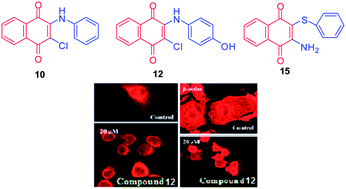Synthesis and evaluation of 2-heteroaryl and 2,3-diheteroaryl-1,4-naphthoquinones that potently induce apoptosis in cancer cells†
Abstract
This article describes the preparation of 2-heteroaryl and 2,3-diheteroaryl-1,4-naphthoquinones by an environmentally benign short synthetic route with the goal of finding 1,4-naphthoquinone derivatives that induce apoptosis in cancer cells. We have identified three most active naphthoquinones 10, 12 and 15 that potently induce apoptosis in human cervical carcinoma (HeLa) cells. One of these three compounds perturbed both microtubule and actin filaments.


 Please wait while we load your content...
Please wait while we load your content...